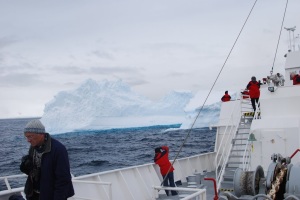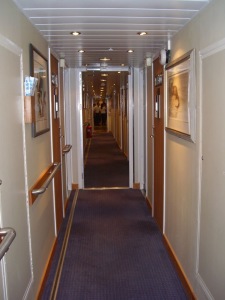I feel as if I’m being shot out of a cannon but never leave the cannon. Or maybe it’s how a baby feels when his Dad tosses him in the air to make him giggle, or a Mom frantically rocks the newborn to stop the crying. We forget our rocking experiences until one dares to travel on feisty seas.
To be honest, yesterday from noon on, the seas were unusually tolerable for these parts. And everyone put on their red jackets with Lindblad-National Geographic patches on the sleeve (these were gifts to be sure we were covered right) and armed with fancy cameras went out on the decks to take pictures. Of what, I couldn’t quite figure out. The sea? As it was the day was gray. OK, t here were birds following us – and they have unusual names. They dive like bombers and cruise like boomers but won’t slow down so you can snap them in your camera frame. It’s not like they pose on the rails or the lifeboats. The serious bird folk will spend hours trying to capture a shot. Some keep a constant eye on the windows to see if an odd bird appears. But it’s cold outside and if nothing else, you’ve got to stay balanced braced against something or ciau baby – and the ocean is freezing. My bird photos are examples of unbalance.
here were birds following us – and they have unusual names. They dive like bombers and cruise like boomers but won’t slow down so you can snap them in your camera frame. It’s not like they pose on the rails or the lifeboats. The serious bird folk will spend hours trying to capture a shot. Some keep a constant eye on the windows to see if an odd bird appears. But it’s cold outside and if nothing else, you’ve got to stay balanced braced against something or ciau baby – and the ocean is freezing. My bird photos are examples of unbalance.
The worse things about these days is the not having anything to do but eat. There are no snacks. A pack of M & Ms would do. There are a handful of persistent athletes sweating on the two treadmills. I tried that at 6:30 a.m. A brave lady who walks an hour a day was doing her stint. I accompanied her for fifteen. Have you ever tried to walk full up hill on a treadmill with the horizon upping and downing like a spastic gyroscope as you try to balance on one of those balance boards? Well, that’s what it is like. Don’t look down at the treadmill or you jettison into space. Keep the eye on the horizon, but that was making me woozy and I don’t get sea sick. (That’s been the salvation of this safari.) There is a stretch class that seems pretty calm so I’m going to try that today. Only about three out of 105 guests participate and this morning it was one, me. My kind of class.
Yesterday afternoon there were two fascinating lectures. It’s hard to believe that these brilliant men (scientists, botanist, biologists, photographers) devote their lives to watching the winds or following birds and penguins or picking up rocks. It is their be all and end all. But they find the information that helps survival on this planet for man and animal.
Steve MacLean talked on Winds, Currents and Life. Did you realize that the North Pole is water surrounded by land and that the South Pole is land surrounded by water? Look at the map. The Northern Hemisphere is called the Land Hemisphere (more land than water) and the Southern Hemisphere is the Water Hemisphere (more water than land.) All the earth is suffering from global warming, but the South Pole less than other zones. MacLean talked about the Coreolis effect – how the cold dense air deviates to the left at the South Pole so the winds and ocean move counter clockwise all around the pole. It’s when a cold dense air described as “rolling downhill” comes up suddenly and severely, the weather can change from dead calm to 60 knots in a snap. Odd things happen in the Southern Ocean, which surrounds Antarctica, but it is not considered in the list of seven oceans around the globe. Only here can you sail around the earth at the same latitude and not see or touch land and likewise the winds circle the globe here without being interrupted by land. (Incidentally, in the North Pole, the Coreolis Effect means that winds off the top of the globe deflect to the right. )
Another point concerns the difference in currents and swells in the ocean. A current is water flowing past a point. If a buoy was in it, it would move forward. A swell is energy moving past but not the water, which if a buoy floated in it would only move up and down and get nowhere. Everyone looks out the windows and thinks these waves are 20 feet swells. But they are exaggerating. Probably yesterday, only 10 feet, although this morning they are major. A swell is measured by wind velocity, duration, and fetch (the distance over water the wind has been blowing.) There was a lot more information, but these notes might be useful in Trivia games.
Now birds. Every bird in Antartica is a sea bird. This means all its food is from marine involvement (not picked up on land unless stolen from the penguins.) The only reason sea birds come to land is to breed and set up their nests. And they have no need for fresh water. They get water from their food and have kidneys. There is a gland in the skull which removes excess salt and this is why often in closeup fotos of Antarctic birds, you see tiny drops of water on their beaks. It takes a sneeze to get rid of the water.
Off the decks of our ship we can see petrals (often called stinkers because they’ll hurl a smelly slime at you if you get too close, something much worse than a skunk odor), albatrosses (they don’t breed on the Antarctic Peninsula) , Kelp Gulls who regurgitate limpid shells, Antarctic terns who are long distance flyers migrating to the North Pole in the winter; South Polar Scuar who are predators to the penguin colonies – love their eggs; shags (sort of sea crows), and the great penguins. We will probably only see three species of penguines. But I’ll hold off on the penguins for a later blog. 
Snapping things of the Sea
Right now, masses of sea birds follow the ship. This afternoon we are expected to reach South Shetland Islands for our first sight of land – (whew) and will park at Aitcho Islands. (The first person to sight an ice berg gets a prize.) We will actually be able to take a Zodiac (rubber boat) to one of the Islands this afternoon – I suppose – unless the wave swells make it impossible. Everything, of course depends on the weather. Sigh. I’m off for an early coffee and muffin.


Hey Mom, Happy Thanksgiving. We have gobbled our big meal and gone for a hike in Percy Warner park. The leaves are at their golden peak. It is a lovely gloomy fall day.
Hang on tight rocking and rolling at the bottom of the planet! We send our love and thankfulness for your adventurous spirit! MM
Hey Mom! Tasha just called me with the news that a 150 passenger ship was sinking in the Antartic. We were glad to find out that you are not on the Explorer but rather the Endeavor. Apparently you are taking on those passengers. I hope you stay clear of icebergs!Hope you get your fill of excitement! We love you! MM
I am due to leave for my Antartic adventure on December 18th and am enjoying reading your postings. Our ship is the MS Andrea. My concern is crossing the Drake Passage which I understand can be a bug-a-boo. Hope all goes well with you and keep up the good work on your trip. I will be looking forward to your pictures when they come across………